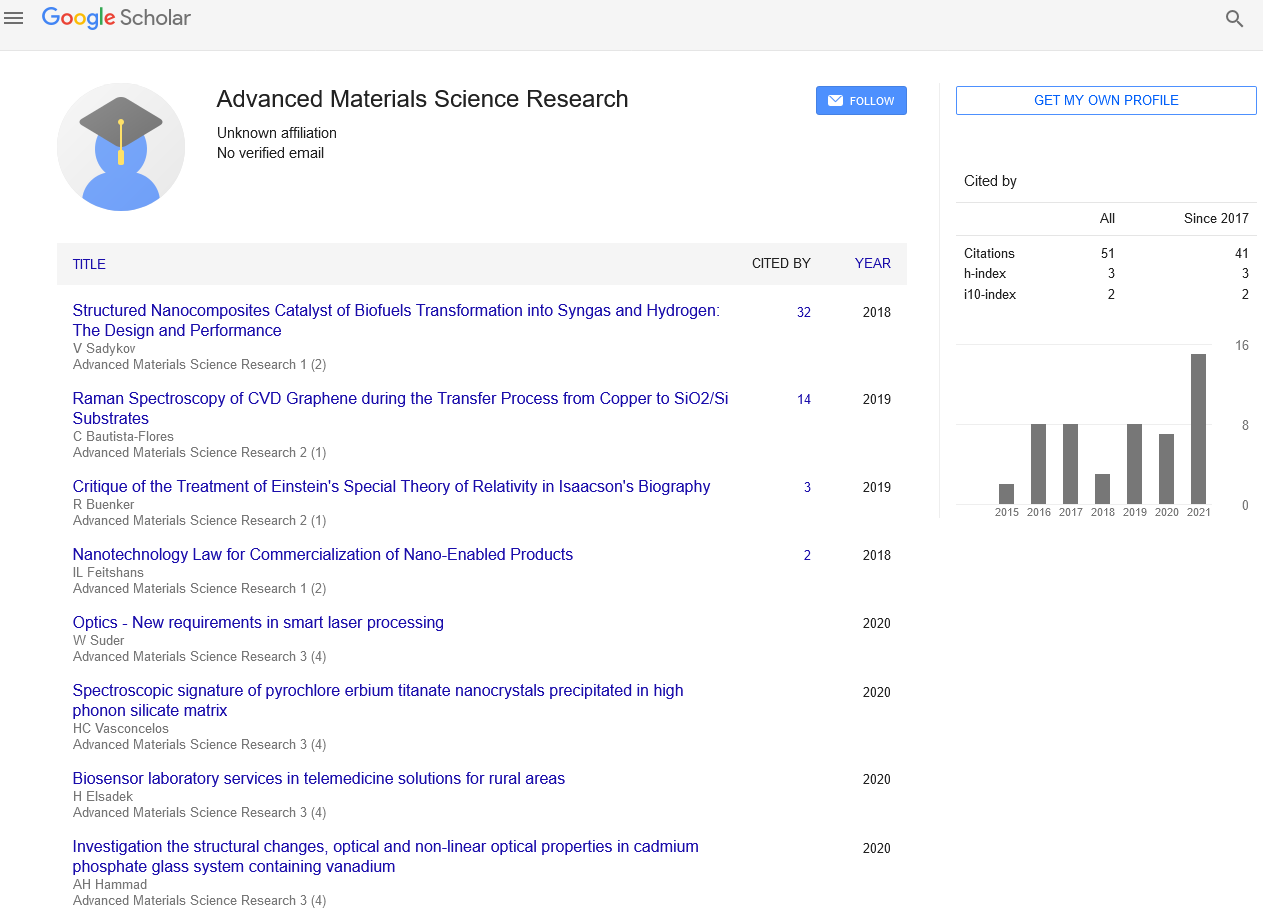Mini Review - Advanced Materials Science Research (2023) Volume 6, Issue 1
Chemical Gas-phase Deposition of Nanostructured Materials Utilizing Laser Photolysis and Thermolysis of Organic Selenides and Tellurides
Jackson Clive*
Department of Advance Material Science Egypt
Department of Advance Material Science Egypt
E-mail: Jackson_c58@gmail.com
Received: 30-Jan-2023, Manuscript No. aaasmr-23-87773; Editor assigned: 01-Feb-2023, Pre-QC No. aaasmr-23-87773 (PQ); Reviewed: 15- Feb-2023, QC No. aaasmr-23-87773; Revised: 18-Feb-2023, Manuscript No. aaasmr-23-87773 (R); Published: 25-Feb-2023; DOI: 10.37532/ aaasmr.2023.6(1).01-03
Abstract
The mechanism of the gas-phase decomposition and the properties of the deposited materials are examined in relation to the laser radiation-induced decomposition of gaseous organic Selenides and Tellurides those results in the chemical deposition of nanostructured materials on cold surfaces. Nanostructured halogen composites and IVA group element chalcogenides can also be made using laser photolysis or thrombolysis of polymer and IVA group element precursors in conjunction with laser photolysis or thrombolysis of the Se and Te precursors, which leads to chalcogten deposition
Keywords
Laser-induced decomposition • Laser-induced deposition • Organ selenium molecules • Organ tellurium molecules • Nanostructured Se- and Te- based materials
Introduction
Studies of the specific roles that the chalcogen atom plays in organic skeletal and the search for synthetic applications of organ selenium and organ tellurium reagents have contributed to the development of organ selenium and organ tellurium chemistry over the past fifty years [1]. In mechanistic and chemical transformations important to synthetic applications, the photolytic and thermo lytic fragmentations of the C-X bonds received a lot of attention. Most of these fragmentations took place in the liquid phase at high temperatures or with conventional UV/ Vis radiation sources [2]. The formation of elemental chalcogen can occur in compounds with C-Xn-C bonds that do not contain any other heteroatoms in their carbon skeleton. The relative stabilities of Se- and Te-centered radicals, as well as the C-Se and C-Te bond dissociation energies, control this process, which is more feasible for Te than for Se. As a result, a mixture of hydrocarbons, Selenides, polyselenides, and elemental selenium is frequently produced when diselenides and Selenides undergo photolysis or thrombolysis [3]. Under flash vacuum pyrolysis of dibenzyl Selenides or diselenacyclophanes, photolysis of ethyl Selenides diindolyl Selenides, or photolysis of Selenides in the presence of phosphine, complete Se extrusion is only possible. There is less use in synthetics for the thrombolysis and photolysis of ditellurides, which yield elemental tellurium and telluride, and of Tellurides, which may result in the formation of elemental tellurium. However, the synthesis of carbocyclic systems and cyclobutenes is made possible by the pyro lytic extrusion of Te from Tellurides, and the gas-phase generation of Te atoms that add to alkenes is made possible by the coupling of allelic halides and photolytic fragmentation of dimethyl telluride [4]. The use of lasers’ intense, highly collimated, and monochromatic radiation to trigger chemical reactions in a wide range of organic and organometallic compounds was first demonstrated in laser chemistry about three decades ago. In various arrangements for chemical vapour deposition of elemental chalcogen and materials composed of elemental chalcogen or metal chalcogenides, the interaction of laser radiation with organic Selenides and Tellurides that results in the extrusion of chalcogen has been studied [5]. The purpose of this review is to discuss how laser radiation affects gaseous organic chalcogenides’ decomposition processes, final volatile products, and solid products that deposit on the cold substrate. There are two methods that use a laser beam that is aimed parallel to cold substrate surfaces [6]. UV laser-induced photolysis and IR laser-induced homogeneous thrombolysis are two examples of these. Organic chalcogenides can be decomposed in a small gas phase volume far from the surface using either process, avoiding the heterogeneous steps that are necessary for conventional pyrolysis.
Methods
The nature of processes induced by lasers
Multiple-photon excitation, either collision less or collisional, moves the absorbing molecule to high vibrational levels of the ground state during the interaction of molecules with IR laser radiation [7]. An extremely stable absorber can be used to sensitize the IR laser process for molecules that do not absorb light. Apart from a few non-obtrusive volatile hydrocarbons, organic chalcogenides decomposition produces elemental chalcogen that agglomerates into nanostructured solid powders or thin films during deposition [8]. This co-decomposition produces nanostructured chalcogen-containing materials when carried out in conjunction with decomposition. Thus a few gaseous precursors can be broken down by either laser photolysis or laser thrombolysis to: nanoscopic metal chalcogenides or polymerencapsulated chalcogen is deposited through the simultaneous gas-phase formation of atoms of chalcogen and metal or chalcogen and polymer and the mutual reaction interaction of these gaseous species.
Chalcogen is deposited: Due to the use of low band-gap and infrared transparent tellurium films as shields in passive radioactive cooling, gas sensors, and optical information storage, as well as the applications of selenium films in microelectronics and photographic imaging, thermal and photolytic chemical vapour deposition of elemental selenium and tellurium is important [9]. There are a variety of steps that take place on the reactor surface or the substrate during conventional thrombolysis and photolysis of organic Selenides and Tellurides, which results in the deposition of selenium and tellurium on hot substrates. As a result, selenoformaldehyde and methane are produced by flash thrombolysis of dimethyl selenite, whereas conventional pyrolysis uses haemolysis of the C-Se bond to produce several hydrocarbons and is influenced by the deposited See’s catalysis. Thermal decomposition of dimethyl telluride in a hot tube, accelerated by the deposited Te, also showed surface involvement. In thrombolysis of higher dialkyl Tellurides, where heterogeneous catalysis contributes to simple bond cleavage and complex elimination steps, it becomes increasingly significant. Organic were found to undergo RTe decomposition via competing C-Te bond haemolysis and a -H-elimination mechanism. And Retch species that quickly break down into Te and a hydrocarbon.
Chalcogen polymer composite deposition
The co-photolysis of both compounds and the codeposition of chalcogen and polymer can occur when gaseous mixtures of Te or Se precursor and a polymer precursor are irradiated by a UV laser. ArF laser irradiation of a gaseous mixture of dimethyl telluride and disilacyclobutane was used to demonstrate this method. The simultaneous photolysis of both substances results in the removal of Te from dimethyl telluride and the formation of a fast-polymerizing, short-lived silene from disilacyclobutane. The occurrence of the intermediate silene and the possibility of its gas-phase polymerization have been reported. The co-photolysis method can be used as an alternative to the only previously reported method for producing polymer-stabilized Te nanoparticles using plasma enhanced chemical vapor co-deposition from diorganyl telluride and some common monomers. The laser-deposited polymer-stabilized Te films contain amorphous Te protected against oxidation in their deeper layers, which makes up more than 1% of the bulk.
References
- Martens J, Praefcke K. Photochemistry of Organic Selenium and Tellurium Compounds. J Organometal Chem. 198, 321–351 (1980).
- Deryagina EN, Voronkov MG, Korchevin NA. Selenium and Tellurium-Centered Radicals. Russ Chem Rev. 62, 1107–1117 (1993).
- Byers JH, Lane GC. Radical Addition Reactions of 2 Phenyls leno Propanedioates to Alkenes and Alkynes. J Org Chem. 58, 3355–3360 (1993).
- Kobayashi K, Shinhara S, Moriyama M et al. Generation of Ketenes by Photolysis of Naphtha [1, 8-de]-1, 3-Dichalcogeninylidene 1-Oxides. Tetrahedron Lett. 40, 5211–5214 (1999).
- Mullin JB, Irwine SJC. Ulraviolet Assisted Growth of II-VI Compounds. J Vac Sci Technol A. 4, 700–705 (1986).
- Higushi H, Otsubo T, Ogura F et al. Flash Pyrolysis of Selenides. Synthesis of Bibenzyls, Olefins and Related Compounds. Bull Chem Soc Jpn. 55, 182–187 (1982).
- Ahlgren G, Åkermark B, Nils M. Bialkyls from Dialkylmetals. I. Photochemistry and Mass Spectra of some (2-cyanoethyl) - and [2(methoxycarbonyl) ethyl] Metals. J Organometal Chem. 30, 303–313 (1971).
- Brown DH, Cross RJ, Millington D. Photolysis of Diorganoditellurides in the Presence of Tertiary Phosphines. J Organometal Chem. 125, 219–223 (1977).
- Spencer HK, Cava MP. Organ tellurium Chemistry Dibenzyl Ditellurides: some Transformations Involving Loss of Tellurium. J Org Chem. 42, 2937–2939 (1977).
Indexed at, Google Scholar, Crossref

